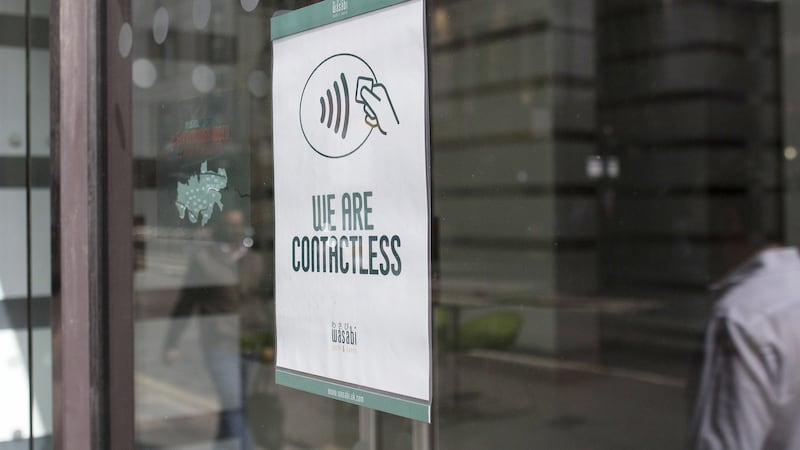When even a church starts accepting mobile payments in lieu of its weekly collection basket, you've got to think that the writing must be on the wall for cash. Last year, one Stockholm church said it received a staggering 85 per cent of its donations via smartphones.
Cash, like fax machines and car phones, is briskly going out of fashion.
In the race to become a cashless society, the Scandinavians are leading the charge. Swedish buses don’t take cash, shops are legally entitled to refuse notes and coins, while churches give out their mobile numbers, rather than collection baskets, so that parishioners can contribute via their phones.

And at the Scandic Hotel in Stockholm, you'll find it difficult to pay for your beer with krona, thanks to a sign that says: "Our bar does not accept cash payments," while even sellers of Sweden's answer to The Big Issue accept digital payments.
According to the Swedish bank, such is the country’s love for digital payments that cash accounted for just 2 per cent of all payments made in the country in 2015 – and this is forecast to drop to just 0.5 per cent by 2020.
Technology has played a large part in the country going cash free. Swish, an app developed by six Swedish banks, started taking mobile payments in 2015, and now some Swedish banks have more Swish transactions than ATM withdrawals.
But it's not just the Swedes; around the world economies are increasingly becoming cashless, facilitated by advancing technologies. Across the US, restaurants such as salad chain SweetGreen, Amsterdam Falafelshop and Clover Food trucks, now refuse cash, requesting instead that customers pay by card or via a mobile wallet.
Here in Ireland, we may lag international trends, but the advent of Android Pay, introduced via AIB and KBC last year, as well as contactless payments on expenses of up to €30, means cash use is diminishing rapidly.
Indeed, in a recent survey by communications group Core Media, 60 per cent of Irish people said they will become cashless in the future, with mobile wallets and peer-to-peer payment technologies due to be adopted first. And it's younger people who will probably drive the transition; while only 15 per cent of people in the Core survey say they have used mobile wallets already, almost one in two millennials say they have used some form of new technology.
But is it possible to give up on cash now?
A month without cash
One pioneering soul who decided to try and live without cash for the month of January was Dr Micheál Collins, assistant professor of Social Policy at the School of Social Policy, Social Work and Social Justice at UCD.
“It was at the back of my head for a while but it was triggered by two things; firstly, I had seen far more electronic transactions for normal day-to-day spending when travelling out of Ireland,” he says, adding that the second factor was the introduction of Android Pay in Ireland before Christmas.
So, with the arrival of Google Wallet, which allows you to pay for goods via your credit/debit card which is linked to your smartphone, Collins decided to try it.
Collins downloaded the Android app, currently only offered by AIB and KBC Bank, and with this, and his debit card for contactless payments, figured he could give it a go.
“I was a bit hesitant initially, waiting for shops to say no,” he says of tapping his phone to pay for purchases. “I survived the month of January . . . but not unscathed. It worked well but I did hit a few problems along the way where I had to spend cash and wasn’t able to use cards.”
For Collins, who kept €15 cash on him , it all came down to travel – in Ireland. To buy coffee on the train to Galway and later to Cork, he had to dip into his pocket, as the trolley service doesn’t accept cards.
Getting back to the station while in Galway also presented a challenge – of a different variety. “I booked and paid for a taxi on a Hailo app, but my colleagues insisted on refunding me for their part of their journey,” he says. “This meant that I ended up leaving Galway with more cash than I had when I got there.”
Apart from that, Collins found avoiding cash almost seamless. From coffee on the way to work and a sandwich at lunch-time, he never needed cash.
“It was very, very easy to do,” he says. However, his muted social life in the month may have made it a bit easier.
“That’s where this might work in January – but not February or March,” he says. The father of two says it was possible, as an individual, to go cashless, “but as a household it could be much more complex”.
Indeed how could you give a child €1 to pay for a new notebook at school, for example?
He concludes that you could probably move 95 per cent of transactions to digital, “but not 100 per cent”.
But did paying for everything with a card mean he spent more? “It’s certainly less tangible, you don’t see the money flowing in and out but I don’t think I’ve spent more or less than I would otherwise have,” he says, adding that it can be even easier to keep a track on mobile payments with your phone, as you get the detail immediately on how much you’ve just spent – and on what.
“It certainly makes expenditure on small transactions much more visible,” he says. So, if you’re spending an excessive amount on regular coffees for example, you’ll learn soon enough once you start using the app.
Collins says he’ll continue tapping his cards as much as possible, but will keep cash too, to “cover the problems that simply do arise”.
The downsides
While there are many proponents of going cashless, there are also concerns. On the one hand, retailers can reduce employee time and payroll costs by eliminating cash registers and trips to the bank – never mind the risk of fraud or theft – but on the other, retailers pay a fee every time a customer swipes a card. So if they are handling more payments via card/smartphone, their transaction costs may rise and that cost may be handed back to the consumer in higher prices.
And what about builders and their so-called “cash prices”? While the absence of cash must be music to the ears of the Revenue Commissioners, and may make tax evasion impossible, consumers may again end up paying more.
You’re also dependent on technology. As Collins notes, “If something goes wrong the whole thing falls apart”.
Another thing is anonymity. Cash leaves no paper trail while digital purchases are recorded for posterity. And do you really want your lender to know just how much you spent on cocktails, or in your local betting office, on the Friday before you had a meeting about a mortgage?
A more pressing concern perhaps is one of exclusion. International evidence suggests that going cash free can disproportionately affects low-income consumers, who may not have either a smartphone, or a debit or credit card – both of which incur higher stamp duty charges for example, than a simple ATM card. In Ireland, in 2011, 100,000 people did not have a bank account – without cash how could these people pay for goods?
Older people too, might find it difficult to wave goodbye to cash – even in Sweden. Last summer, the Swedish National Pensioners' Organisation launched a campaign entitled "Cash is needed" to try and get the government to safeguard the future of cash. When the European Central Bank scrapped the €500 note last year, Jens Weidmann, Bundesbank president, said it would be "fatal if citizens got the impression that they are dispossessed of cash".
And what about banks’ reluctance to pass on negative interest rates to retail customers; if consumers can’t withdraw cash at their own discretion, unless it’s to place it in another digital repository, what’s to stop banks saddling savers with negative rates?
In Massachusetts, retailers have run into difficulty as it's illegal to outlaw cash; here in Ireland however, there are no such concerns. According to the Central Bank, it has no regulatory or supervisory powers in relation to retail outlets. "As contract law governs the sale of goods, retail outlets are free to decide the means of payment they are prepared to accept for the sale of goods."
Cashless costs
But whatever about the pros or cons of a cashless society, it will only become a reality if it’s economical to do so. As Collins notes, what facilitated his experiment was the fact that his bank, AIB, has waived charges on contactless payments for the foreseeable future.
“I couldn’t justify it if the cost of each transaction was just too high,” he says.
Indeed, as our table shows, none of the banks operating in Ireland charge very much for contactless/android payments, with Bank of Ireland levying €0.01 per transaction.
By comparison, withdrawing money from an ATM can cost up to 35 cent (AIB) or 30 cent with KBC Bank, while paying with your chip and pin is also more expensive: 20 cent with AIB or 10 cent with Bank of Ireland. Of course if you qualify for free banking, these charges may not influence your behaviour.
If you don’t, and faced charges of 20 cent on a €2.50 cup of coffee, then contactless/Android Pay just wouldn’t make sense.
“I would have thought, if the cost of using technology rather than cash is small, then cash will fade away fairly rapidly over next while,” says Collins.










